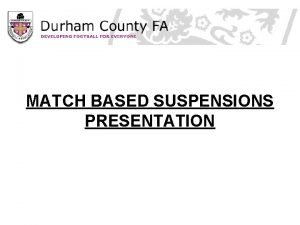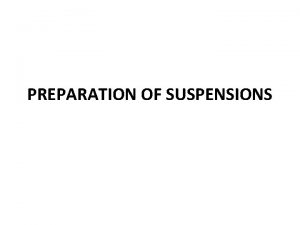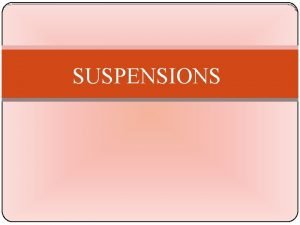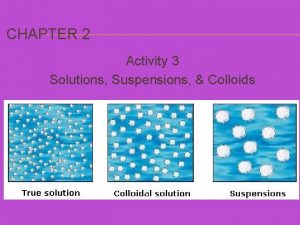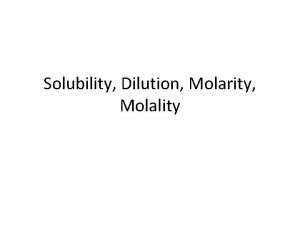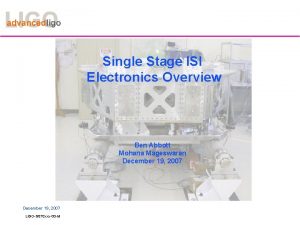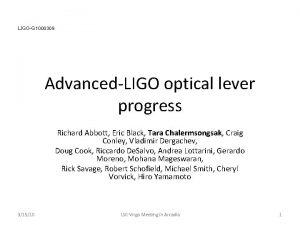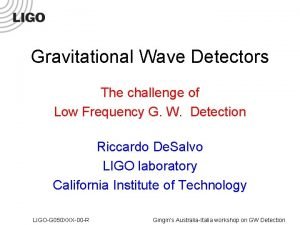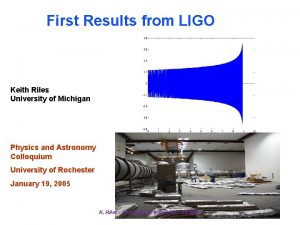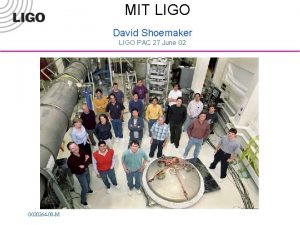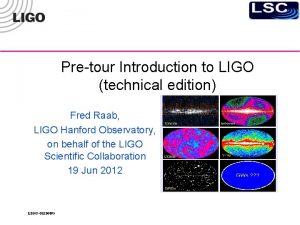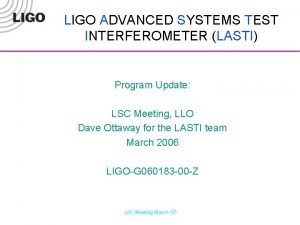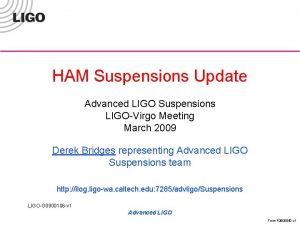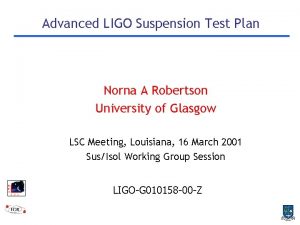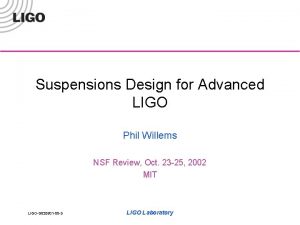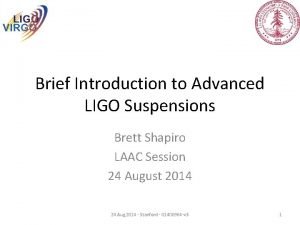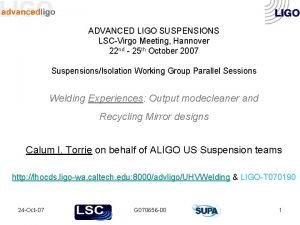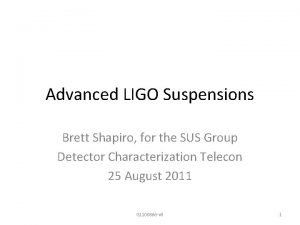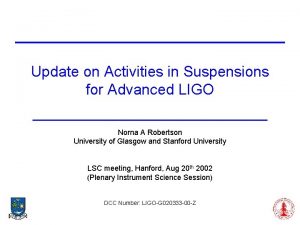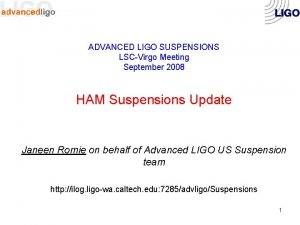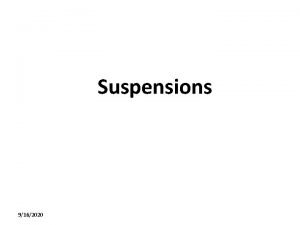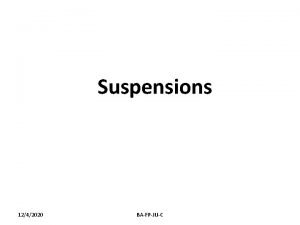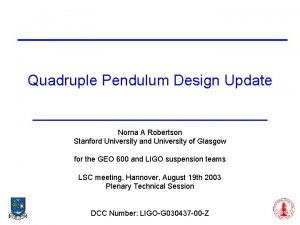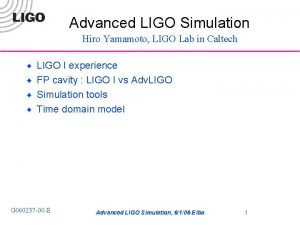Conceptual Design for Advanced LIGO Suspensions Norna A














- Slides: 14

Conceptual Design for Advanced LIGO Suspensions Norna A Robertson University of Glasgow and Stanford University for the GEO suspension team +contribution from Mark Barton (Caltech) LSC meeting, Livingston, March 22 nd 2002 (Suspensions and Isolation Session) DCC Number: LIGO-G 020029 -00 -Z

Conceptual Design • Conceptual design presented at Design Requirements Review, Sept 20 th, 2001 • presentation DCC number: G 010379 -00 -D • document DCC number: T 010103 -01 -D • Design requirements document also presented (ref. Willems) • Target sensitivity 10^-19 m/rt. Hz at 10 Hz at each of the main mirrors, and falling above this frequency (ref. discussion of low frequency cut-off, Fritschel, to follow). • First prototype quad. pendulum suspension under test at MIT (ref. Mittleman, to follow)

Baseline Design for Adv. LIGO suspensions • Fused silica ribbons suspending 40 kg sapphire mirror – lowest mass in quadruple pendulum • Quadruple pendulum incorporating 3 stages of enhanced vertical isolation using blades • Local control sensors/actuators or eddy current damping on top mass • Overall length ~ 2 m • All locally controlled freqs. in range ~0. 4 - 4. 5 Hz • Global control: hierarchical feedback, acting against quad. reaction pendulum

Schematic Diagram of Quadruple Pendulum

Current Baseline Design • • Final mass: 40 kg sapphire, 31. 4 cm x 13 cm Penultimate mass: 72 kg (heavy glass) Upper masses: 36 kg, 36 kg Overall length: 1. 7 m (from top blade to centre of mirror) • Ribbon parameters: • length 60 cm • cross-section 113 m x 1. 13 mm • stress in ribbon 770 MPa

Quadruple Pendulum: Thermal Noise light solid curve – baseline, heavy solid curve – light penultimate mass, dotted line – sapphire internal thermal noise

Open Issues/Areas of Research: Overall Design and Thermal Noise Aspects • • Use of sapphire or silica (and size): downselect Nov 02 Choice of lower frequency cut-off: for low frequency require • • Ribbons or fibres (constant or varying x-section) • • Research on manufacture, strength, reliability, loss, possible use of twists recent result – strength of ribbons >1. 8 GPa Bonding of silica to sapphire and heavy glass • • • Long fibre length in final stage (~60 cm) Use of heavy penultimate mass Fibres/ribbons of low x-section Losses Strength Final design of silica ears Plan to test assembly and suspension of sapphire ( 25 cm diam x 12 cm thick) from heavy glass penultimate mass at Glasgow Materials issues (coating losses etc – as discussed in joint morning session) Engineering issues Research on above at Caltech, Glasgow, MIT, Stanford, Syracuse

Example of engineering issue: blade adjustment • Experience with MIT quad prototype: position of blade tip in vertical direction more critical than in GEO design for mode frequencies and coupling. Prototype adjuster being developed in Glasgow pre adjustment post adjustment

Open Issues/Areas of Research: Local Control • Use of active control - require isolation of sensor noise. Key factors: • • Sensor noise level Isolation of sensor noise by multiple pendulum Allowable level of residual motion (residual Qs) Possibility for global actuation to take over (certain degrees of freedom) • Possible alternative – eddy current damping. • Thermal noise level OK: for Q~10 (lowest mode) ~4 × 10^-20 m/rt Hz at 10 Hz • Fixed Qs OK? • Require diagnostic sensors and actuators as well? Plan to test eddy current damping of multiple pendulum at Glasgow

Longitudinal Transfer Function: Damping of Modes Active Control Q=10. 0 Q=7. 2 Q=2. 7 Eddy Current Damping Q=2. 8 Q=10. 0 Q=4. 2 2 2 10 10 0 0 10 10 -2 -2 10 10 -4 -4 10 10 -6 -6 10 10 -8 -8 10 10 -10 10 Q=7. 3 Q=1. 9 -10 0 1 10 10 Frequency (Hz)

Sensor Noise – Transfer Functions (TF) Longitudinal (left) and vertical transfer function (TF) from sensor to mirror for quadruple pendulum with sensor at the top mass. Gain is such that lowest frequency peak has Q ~10 If gain decreased by factor f, Q increases by factor f. Let gain fraction = 1/f TF at 10 Hz: ~2 x 10^-7/rt Hz (long. ) ~2 x 10^-4/rt Hz (vert. )

Residual Sensor Noise at Mirror at 10 Hz sensor noise × TF (× x-coupling) × gain fraction < 10^-19 m/rt Hz 10^-10 10^-11 5 × 10^-13 × × × 2 × 10^-7 × × × 5 × 10^-3 = 10^-19 m/rt Hz 5 × 10^-2 = 10^-19 m/rt Hz 1 = 10^-19 m/rt Hz Above figures hold for both longitudinal and vertical directions, where x -coupling factor for the latter taken as 1 × 10^-3. Current GEO sensors: 10^-10 m/rt Hz, with range ~ 1 mm

Open Issues/Areas of Research: Global Control • Global control – issues • • Required bandwidth, magnitude of drive for different mirrors Details of hierarchical feedback Final stage – electrostatic or photon pressure? Violin mode damping – passive as in GEO? (small regions of PTFE coating used to reduce Q’s to ~10^6) Quad. prototype and subsequently LASTI controls prototypes will be used for investigations

Some Current Activities • Controls prototypes for LASTI: • Modecleaner (triple) detailed design underway at Caltech, based on GEO signal recycling mirror suspension • Recycling mirror (triple) detailed design to follow, then test mass (quad) • Electronics for controls p’types: design underway (Glasgow/Caltech) The triple prototypes will be tested on LIGO 1 -type isolation stage • Prototype quad currently at MIT to move to Caltech for further tests • Modelling: Extended quad model developed by M Barton, compared to existing MATLAB model - see next slides.
 Suspension solution
Suspension solution Durham fa suspensions
Durham fa suspensions Ingredients for suspensions
Ingredients for suspensions Advantages of flocculated suspensions
Advantages of flocculated suspensions Solutions, suspensions and colloids activity
Solutions, suspensions and colloids activity Suspension and colloids
Suspension and colloids Xxx00m
Xxx00m Richard abbott ligo
Richard abbott ligo Ligo challenge xxx
Ligo challenge xxx Ligo detections
Ligo detections Ligo science education center
Ligo science education center Ligo science education center
Ligo science education center David shoemaker ligo
David shoemaker ligo Ligo
Ligo Ligo
Ligo

